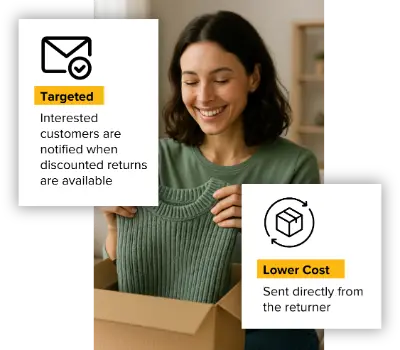Amazon Vine Reviews Are Now Allowed Pre-Launch (July 2025 Update)

Last updated on July 15, 2025

In this article
 15 minutes
15 minutes
- What Is Amazon Vine (and How Did It Work Before 2025)?
- What Changed in July 2025? (Pre-Launch Reviews are Live!)
- A Boost for Conversion and Ranking
- Who Can Use Vine Now? (It’s Not Just Brand Owners Anymore)
- How Does Pre-Launch Vine Compare to the Past?
- Tips for Sellers: Making the Most of Vine’s New Powers
- Final Thoughts
- Frequently Asked Questions
Imagine launching a brand-new product on Amazon, and on day one, it already has a full page of glowing reviews. Sounds almost too good to be true, right? Well, Amazon just flipped the script for sellers. As of July 1, 2025, the Amazon Vine program got a major upgrade. Vine Voices (Amazon’s invite-only community of top reviewers) can now post product reviews before your listing even goes live. In other words, eligible products can launch with up to 30 real Amazon customer reviews on day one, and these reviews are immediately visible to Amazon customers, giving shoppers instant insight and confidence. This is a huge deal for Amazon sellers looking for an early boost in conversion, ranking, and customer trust.
What Is Amazon Vine (and How Did It Work Before 2025)?
For those not familiar, Amazon Vine is a program where a select group of trusted reviewers, called Vine Voices, receive free products from Amazon sellers or brands in exchange for writing honest, unbiased, and insightful reviews. These Vine members are not paid (aside from the free item) and are chosen based on their reviewer rank and past helpful votes from the Amazon community. Reviewers are invited to join the Vine program based on their review activity and reputation. Once invited, reviewers must accept the invitation to participate in the Vine program. Consistently buying things on Amazon and leaving detailed reviews can increase a customer’s chances of being noticed and eventually invited to the Vine program. The goal is to generate high-quality reviews that help other customers make informed buying decisions. Vine has been around for quite a few years (since the late 2000s), originally as an invite-only club for top reviewers.
In the past, Amazon Vine was available only to 1P vendors, but in recent years, Brand Registered 3P sellers have also been allowed to participate through Seller Central, provided their listings met Amazon’s criteria. But it wasn’t cheap; Amazon used to charge a hefty fee (around $200 per ASIN for many sellers) to participate. You’d create a new listing, enroll it in Vine, and then wait. Vine reviewers would claim the product, get it shipped for free, and then post a review after trying it out. However, those reviews would only appear post-launch (once your listing was live and the Vine member submitted their feedback). This meant new products often spent days or weeks with zero reviews until Vine Voices or early buyers chimed in. Sellers often had to hold off on big marketing pushes (like PPC ads) because a product with no reviews is a tough sell; most shoppers won’t even consider a product if nobody’s vouching for it. In fact, one analysis found that displaying at least five reviews can increase conversion rates by up to 270%, which shows how critical initial reviews are for buyer confidence.
Slash Your Fulfillment Costs by Up to 30%
Cut shipping expenses by 30% and boost profit with Cahoot's AI-optimized fulfillment services and modern tech —no overheads and no humans required!
I'm Interested in Saving Time and MoneyWhat Changed in July 2025? (Pre-Launch Reviews are Live!)
The big news is that Amazon now allows Vine reviews to be posted before a product’s public launch. This means you can have a full roster of reviews ready to go the moment customers first see your listing. Here’s how it works in practice:
- You create your Amazon listing but keep it in a “not yet live” state.
- Enroll that ASIN into the Amazon Vine program through Seller Central (it must be an FBA item in new condition, with fewer than 30 existing reviews, and you need to have a Professional seller account with Brand Registry).
- Specify the quantity of units (typically up to 30) you want to make available for review, and provide products to Vine reviewers by sending these units for them to test.
- Vine reviewers request your product, receive the free product shipment, and start testing it out immediately.
- These Vine members can then write their reviews before the product is available to the general public. Amazon holds those reviews in a queue.
- When you’re ready, you “flip the switch” to make the listing live for sale, and bam! All the Vine reviews that were written pre-launch become visible on your product page from day one.
Pretty cool, right? It’s essentially seeding your new product with social proof right out of the gate. Previously, reviews had to be gathered after launch, which delayed that crucial social proof and made launching a new ASIN feel like pushing a boulder uphill. Now, with Vine pre-launch reviews, Amazon sellers can start with momentum. By providing products and specifying the quantity for Vine, you can receive reviews from Vine members before your product is available to the general public. Imagine launching with 25 – 30 reviews that are labeled as “Vine Voice,” customers immediately see that real people have tried the product and shared their thoughts. This can only help conversions. Amazon itself touts that using Vine can boost sales by up to 30% for new launches (and that stat might climb higher now that the reviews can appear sooner).
A Boost for Conversion and Ranking
From a conversion optimization standpoint, this change is gold. Early reviews mean higher conversion rates because shoppers feel more confident. Instead of being the dreaded “zero-review” product that people skip over, your item has a healthy chunk of feedback. Social proof drives behavior; a shopper is far more likely to buy something that already has, say, 25 reviews and a 4.5-star rating versus a blank slate. There’s even evidence that just having a handful of reviews dramatically increases the likelihood of purchase (remember that five reviews = +270% conversion stat). Now you can potentially have those five (or twenty-five) reviews immediately. Early Vine reviews can also highlight key features, answer questions, and add photos or videos. Many Vine Voices write very detailed reviews, sometimes even uploading unboxing pics or demo videos, which can enrich your product page content. Vine reviewers often post their feedback within a week of receiving the product, helping to build early momentum for your launch. All of this not only convinces customers but also feeds Amazon’s algorithm, products with more engagement (reviews, Q&A, etc.) tend to get a boost in search ranking. It’s like jumping to level 5 while your competitors are starting at level 1.
However, there’s a flip side: Vine reviews are unbiased and not guaranteed to be positive. Vine members are asked to give honest opinions. If your product has flaws or doesn’t meet expectations, Vine Voices will call it out. This is risky if you rush a product that isn’t ready for prime time. The last thing you want is 10 bad reviews at launch because that can tank conversion just as fast. Even a single negative review from a Vine reviewer can significantly impact a seller’s life and business trajectory, affecting both reputation and future sales. So, while it’s tempting to enroll every new item in Vine, smart sellers will make sure the product is solid and the listing details are accurate to set reviewers’ expectations correctly. The Amazon Vine program isn’t about churning out good reviews; it’s about getting accurate and insightful reviews quickly. The hope is they’re positive, but they’ll be honest above all. In our experience, Vine Voices often provide balanced feedback, usually positive if the product delivers value, with constructive criticism if not. They have no reason to “spam” or slant things because their Vine status can be revoked if they abuse the program. (Remember, Vine members are selected by Amazon and want to maintain a good standing. Their reviews are marked with a special badge, and other customers can vote if the review was helpful, so Vine reviewers strive to be fair and thorough, not to mention they’ve been doing this for years. As a trusted source, feedback from Vine reviewers can shape a product’s reputation and influence its success.)
Looking for a New 3PL? Start with this Free RFP Template
Cut weeks off your selection process. Avoid pitfalls. Get the only 3PL RFP checklist built for ecommerce brands, absolutely free.
Get My Free 3PL RFPWho Can Use Vine Now? (It’s Not Just Brand Owners Anymore)
Another notable change is who’s eligible to enroll products in Vine. Historically, only brand owners (sellers with their brand in the Amazon Brand Registry) or vendors could use Vine. But Amazon has quietly expanded access. Now, authorized resellers can also participate in Vine for a brand’s products if they meet certain criteria. Essentially, if you’re a reseller who has been added as an official Brand Representative or Reseller on a brand’s Amazon account (via Brand Registry), and you have a Pro seller account with FBA, you can enroll that brand’s ASINs into Vine. Selling on Amazon is now more accessible for resellers who want to leverage Vine reviews to promote and gather feedback on their products.
This is a pretty big shift. It means brands can partner with their key third-party sellers to share the cost and effort of generating reviews. For example, if you distribute your product to a few authorized sellers, those sellers could volunteer to enroll new ASINs in Vine (spending their resources to give away units) to help kickstart sales for both of you. Amazon’s essentially saying, “We’ll allow more players to help get authentic reviews on new products.” The reviews still attach to the product (ASIN), not to any one seller, so it benefits the whole listing. From a brand perspective, that’s great—less pressure for you to do all the work for every new launch. From the reseller perspective, it’s a way to add value and potentially secure more buy box time if you help a product succeed (plus you’ll likely coordinate with the brand on this). The Amazon site serves as the central platform for coordinating these reviews and selling activities. It’s a win-win as long as everyone’s aligned.
How Does Pre-Launch Vine Compare to the Past?
Let’s put this into perspective. Previously, launching a new product meant you either crossed your fingers for organic reviews (slow and painful), or you enrolled in Vine and waited a few weeks post-launch to accumulate maybe 5 – 20 Vine reviews, or perhaps you used other programs (like Amazon’s Early Reviewer Program, which was discontinued in 2021). It always felt like a race to get that first review. Many sellers felt stuck because a product with zero reviews rarely gets purchased, but to get reviews, you need purchases—a classic chicken-and-egg problem. Vine was one solution, but it wasn’t instant.
Now, Amazon has essentially removed that lag. You can start day one with social proof in place. That’s a huge competitive advantage. It’s almost like having a built-in base of customer testimonials at launch. This drastically changes launch strategies. Sellers can confidently run ads immediately, knowing they have some review credibility. You can drive external traffic without fear that shoppers will bounce when they see “No reviews yet.” It’s also a confidence booster for the seller; launching is less scary when you’re not starting from zero.
From the buyer’s side, shoppers might not even realize the reviews were pre-launch Vine reviews; they’ll just see that green Vine Voice tag and presumably think, “Oh, someone in the Amazon community reviewed this.” Many savvy buyers know the Vine badge means the reviewer got the item for free, but they also recognize that Vine reviews tend to be detailed and genuine, not the one-liner spam reviews you sometimes see. Over the years, Amazon Vine reviews have a reputation for being thorough (often lengthy, with pros and cons listed). Many Vine Voices wrote detailed feedback that contributed to the program’s credibility. Still, some shoppers may wonder about the authenticity of reviews, especially with the prevalence of fake reviews. Amazon has sometimes been unable to fully prevent fake or biased reviews, which is why programs like Vine are important. In theory, that quality should remain high because Amazon still controls who gets to be a Vine Voice.
Scale Faster with the World’s First Peer-to-Peer Fulfillment Network
Tap into a nationwide network of high-performance partner warehouses — expand capacity, cut shipping costs, and reach customers 1–2 days faster.
Explore Fulfillment NetworkTips for Sellers: Making the Most of Vine’s New Powers
If you’re planning to use Vine’s new pre-launch feature, here are a few tips and insights:
- Ensure your product is ready: Don’t treat Vine as a magic bullet for a mediocre product. Vine reviewers will call out issues. You want those first 20 – 30 reviews to be overwhelmingly positive, if possible. Make sure you’ve tested your product, your quality control is on point, and your listing description is accurate (so Vine members aren’t surprised by anything). Using high-quality materials is crucial to avoid negative feedback and ensure durability, which can lead to better reviews and customer satisfaction. The Vine community has been around a long time; they’ve seen it all, and they will notice if something’s off.
- Time your Vine enrollment strategically: Ideally, you want Vine reviews to come in right around your target launch date. Vine reviewers typically post within a couple of weeks of receiving the product (some are quicker). It might make sense to enroll in Vine and ship units maybe 2 – 4 weeks before your intended “go live” date. That way, by the time you make the product available for sale, a chunk of Vine reviews are already written (or will be written soon). You can technically launch as soon as one Vine review is in (even one review is better than zero, sometimes one review can make the difference for that first shopper). But waiting until you have, say, 10+ reviews ready could make a stronger splash.
- Leverage the momentum: Once you launch with Vine reviews, capitalize on it. Ramp up your advertising (since now your ads show a product with a star rating), consider promotions, and monitor your conversion rate. You might find you can charge a premium price if those early reviews are stellar, because the value of social proof is significant. Also, those first reviews can reveal any common questions or minor cons that you can address quickly (either by updating your listing copy or in a future product iteration).
- Stay within Amazon’s rules: Vine is Amazon-sanctioned, but that means you need to stick to the program guidelines. Don’t try to influence Vine reviewers (no reaching out to them to beg for a 5-star rating, a big no-no). Also, you have to eat the cost of those free units and the Vine enrollment fee (if any). The good news is Amazon has made Vine more accessible cost-wise, as of 2025, new Brand Registry sellers get a $200 Vine credit and can enroll up to 2 products for free. Additional enrollments might cost a nominal fee (much less than $200 in many cases). Always check the latest Vine fee structure in Seller Central.
- Monitor the outcomes: Keep an eye on how those Vine reviews perform. Are they getting “helpful” upvotes from other customers? A review with many helpful votes will rise to the top of your review section, becoming the de facto first impression. Vine Voices often write “insightful reviews” that others mark as helpful, which is great. If a Vine review highlights a product improvement, consider commenting on it or actually making that improvement. Showing that you’re attentive to feedback can turn a potentially negative point into a positive for future customers reading the reviews. Be prepared to handle refund requests if Vine reviews reveal significant product issues, as managing refunds promptly can help maintain your seller reputation. If you encounter problematic or inappropriate reviews, remember you can report them to Amazon for review and possible removal.
Final Thoughts
In summary, Amazon’s new Vine update is a game-changer for launching products. It levels the playing field a bit between new entrants and established products. Now, even a brand-new ASIN can look seasoned from day one. It’s not an exaggeration to say this could be one of the most impactful changes to Amazon’s review ecosystem in years. We’re pretty excited about it (as you can probably tell). It aligns with Amazon’s push to help trusted brands and sellers hit the ground running, while still providing accurate and insightful reviews for customers.
As ecommerce operators, we live and die by reviews and customer trust. Seeing Amazon allow pre-launch reviews is like getting a head start in a marathon. You still have to run a good race (i.e., have a good product, good marketing, and all that), but at least you’re not starting 50 yards behind the line with a blindfold on. Take advantage of this if you can. And if you need help strategizing your launch or managing the logistics (after all, once those orders roll in, you’ve got to fulfill them seamlessly, that’s where Cahoot can help on the fulfillment side), don’t hesitate to reach out to experts or partner services.
Happy launching, and may your new products rack up Vine reviews and sales in record time!
Frequently Asked Questions
What’s changed with Amazon Vine in July 2025?
Sellers can now get Vine reviews before a product goes live, giving listings a major head start.
How many reviews can you get before launch?
Up to 30 Vine reviews can be posted pre-launch.
Why do pre-launch reviews matter?
They improve conversion rates, boost search rankings, and create early trust.
Do Vine reviews cost money?
Sellers provide the product for free, but Amazon charges a submission fee per ASIN.
Is Vine worth it for new products?
Yes, especially for higher-priced or competitive items where early momentum is crucial.

Turn Returns Into New Revenue





